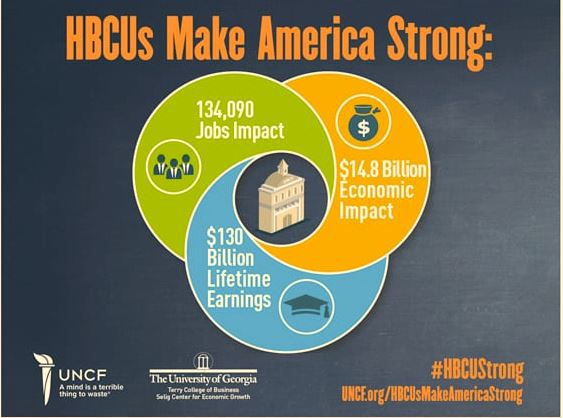Historically Black Colleges and Universities
History and Facts
Source: HBUC First; U.S. Department of Education;
Historically Black Colleges and Universities (HBCUs) are public and private institutions established before the Civil Rights Act of 1964 in the United States. From their inception, HBCUs presented Black people with access to education, which was denied to them during slavery and segregation. The institutions also provided a safe space to learn, discover and build community.
The Beginning
After the Civil War (1861-1865), HBCUs emerged to provide Black Americans the most basic of human rights — access to a full education.
Prior to the Civil War, the education of Black Americans was prohibited in most Southern states and often discouraged in Northern states resulting in only a few Black schools being in existence.
These laws existed because slave owners and anti-abolitionists feared that if enslaved and free people of color became literate, they would no longer be able to control them. Without that control, their economy, which was built on slave labor, would collapse.
Free people of color were allowed to attend white universities in states that abolished slavery; they still faced overt racism and discrimination by their white peers. Black students also tended not to fare well at white institutions because there were significant gaps in their knowledge and college readiness.
Most of our nation’s HBCUs were started by philanthropists and free Blacks; Southern states at the behest of the federal government; and religious organizations such as the American Missionary Association (AMA) and the African Methodist Episcopal (AME) Church.
The first HBCUs were established to educate the children of formerly enslaved people and train them to teach other Black Americans. Because HBCUs were the only schools available to most Black Americans, they often provided primary, secondary, and postsecondary education.
The Renaissance
From the late 1800s to the late 1900s, HBCUs thrived and provided refuge from laws and public policy that prohibited Black Americans from attending most colleges and universities. They provided undergraduate training for 75% of all Black Americans holding a doctorate degree; 75% of all Black officers in the armed forces; and 80% of all Black federal judges.Before higher education was desegregated in the 1950s and 60s, almost all Black college students enrolled at HBCUs. Legal segregation had prevented Black Americans from attending college in the South, and quotas limited the number of Black students that could attend college in the North.
Today
Today, all 107 HBCUs across the United States continue to play a vital role in America’s prosperity — academically, socially, and economically, and they enroll more than 228,000 students.
HBCUs are also becoming a magnet for international students — largely due to their strong academic programs, affordability, and diverse & inclusive environments. Originally founded to educate Black Americans, today 1 in 4 students (24%) enrolled at HBCUs are non-Black.
The Growth of HBCUs
Seeing a need and opportunity for reform, Quaker philanthropist Richard Humphreys founded the Institute for Colored Youth in Cheyney Pennsylvania in 1837. He wanted to create an institution for formerly enslaved African Americans to learn basic skills like reading, writing and math so they could become equipped for the world that they were entering as free people. On February 25th, 1837, Cheyney University of Pennsylvania became the nation’s first Historically Black College and University (HBCU).
After the passing of the Second Morrill Act of 1890 – which required states that supported racial segregation in schools to create and fund public institutions for Black students. Gradually, more universities were established with a large surge of new institutions coming into existence. Schools that served Black communities faced many hurdles with funding and access to resources being a major barrier. This increase in funding led to more Black people attending college and thus a need for more schools.
The Impact of HBCUs Today
While HBCUs are no longer the only path to higher education for people of African descent, due to the Civil Rights Act of 1964, Black students still attend them in increasing numbers. HBCUs remain a refuge for students to delve further into their cultural heritage and excel academically without fear of discrimination.
Whether it is the groundbreaking STEM and liberal arts programs, low-cost tuition, dynamic atmosphere, or large diversity of students and professors, students are looking to HBCUs for a quality education and reflective cultural experience.
The growing enrollment of ethnically, religiously and culturally diverse students at HBCUs encourage the federal government to respect and invest in the institutions. Legislation continues to pass that strengthens educational resources, increases administrative capacity and provides great financial assistance for students at these powerful think tanks.
HBCUs are golden products of the African diaspora and symbols of the strength and resilience of Black people. Their rich culture and academic rigor have allowed them to persevere despite continued obstacles.
Notable Black Americans that graduated from HBCUs
There is a long list of notable alumni, such as: Spike Lee (Morehouse); Toni Morrison and Vice President Kamala Harris (Howard University); Oprah Winfrey (Tennessee State University); Dr. Martin Luther King Jr. (Morehouse College); the first Black U.S. Supreme Court Justice Thurgood Marshall (Lincoln University, Howard University); and NFL Hall of Famer and TV Host Michael Strahan (Texas Southern University).

